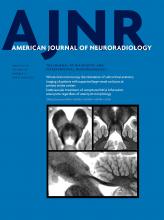Abstract
BACKGROUND AND PURPOSE: Disappearance of T2 lesions into CSF spaces is frequently observed in patients with MS. Our aim was to investigate temporal changes of cumulative atrophied brain T2 lesion volume and 10-year confirmed disability progression.
MATERIALS AND METHODS: We studied 176 patients with relapsing-remitting MS who underwent MR imaging at baseline, 6 months, and then yearly for 10 years. Occurrence of new/enlarging T2 lesions, changes in T2 lesion volume, and whole-brain, cortical and ventricle volumes were assessed yearly between baseline and 10 years. Atrophied T2 lesion volume was calculated by combining baseline lesion masks with follow-up CSF partial volume maps. Ten-year confirmed disability progression was confirmed after 48 weeks. ANCOVA detected MR imaging outcome differences in stable (n = 76) and confirmed disability progression (n = 100) groups at different time points; hierarchic regression determined the unique additive variance explained by atrophied T2 lesion volume regarding the association with confirmed disability progression, in addition to other MR imaging metrics. Cox regression investigated the association of early MR imaging outcome changes and time to development of confirmed disability progression.
RESULTS: The separation of stable-versus-confirmed disability progression groups became significant even in the first 6 months for atrophied T2 lesion volume (140% difference, Cohen d = 0.54, P = .004) and remained significant across all time points (P ≤ .007). The hierarchic model, including all other MR imaging outcomes during 10 years predicting confirmed disability progression, improved significantly after adding atrophied T2 lesion volume (R2 = 0.27, R2 change 0.11, P = .009). In Cox regression, atrophied T2 lesion volume in 0–6 months (hazard ratio = 4.23, P = .04) and 0–12 months (hazard ratio = 2.41, P = .022) was the only significant MR imaging predictor of time to confirmed disability progression.
CONCLUSIONS: Atrophied T2 lesion volume is a robust and early marker of disability progression in relapsing-remitting MS.
ABBREVIAITONS:
- CDP
- confirmed disability progression
- EDSS
- Expanded Disability Status Scale
- LV
- lesion volume
- PBVC
- percentage brain volume change
- PCVC
- percentage cortical volume change
- PVVC
- percentage ventricles volume change
- RRMS
- relapsing-remitting MS
- © 2019 by American Journal of Neuroradiology












